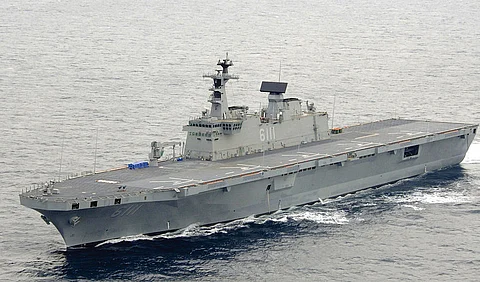

The operational responsibilities of Seoul's Republic of Korea Navy (ROKN) include countering maritime incursions from North Korea's navy, safeguarding sea lines of communication, and, in co-operation with the Korea Coast Guard, supporting South Korea's claims to the Dokdo (Takeshima) islands in the Sea of Japan, claims that are disputed by Tokyo.
The prime system for responding to intruding North Korean speedboats, hovercraft, and midget submarines has been ROKN Lynx and Wildcat helicopters armed with British Sea Skua and, more recently, Israeli Spike missiles.
The past 20 years have seen the ROKN undergo radical expansion and modernisation, driven by a need to respond both to the headlong expansion of China's PLA Navy and the upgrading of many other Asian maritime forces. amid uncertainty over future US commitments to the region. Seoul's aim is to have three battlegroups permanently available for deployment.
Currently at the core of ROKN ambitions is the project to build an aircraft carrier. The projected vessel will displace about 30,000 tonnes and will feature a ski jump take-off aid, a vertically launched missile system, and a dedicated area for operation of uncrewed aerial vehicles. Available imagery shows a two-island configuration.
UK's Babcock has entered into an agreement to work jointly on the project, while another major South Korean shipbuilder, DSME, is also competing for the contract. A total of 40 F-35B short take-off and vertical lading (STOVL) fighter bombers are on order, with 20 of them to be assigned to carrier-borne operations.
The planned commissioning of an aircraft carrier, at least in part a response to Japan's return to the fixed-wing naval aviation fold, will no doubt enable the ROKN to take a lead role in regional multilateral exercises.
The ROKN already has two large flat top aviation platforms in service, namely, the amphibious warfare vessels Dokdo and Marado .These ships can operate up to 15 helicopters apiece and have strong command and control facilities.
Early September saw the importance of submarine operations in the waters off the Korean Peninsula underscored, when the ROKN submarine Dosan Anh Changho fired a Hyunmo 4-4 ballistic missile while submerged, and did so within hours of a North Korean submarine launching two missiles from below the surface of the sea.
The ROKN operates nine Son Wonyil-class and nine Chang Bogo-class submarines. Based on a German design, all are armed with torpedoes and Harpoon anti-shipping missiles, and some feature air-independent propulsion (AIP). One 3,800-tonne Dosan Ann Changho-class is in service and two more are under construction out of a total of nine planned. These large subs have AIP, and their armament includes heavyweight Tigerfish torpedoes as well as anti-shipping and ballistic missiles.
In the vanguard of the ROKN escort fleet are the three 11,100-tonne destroyers of the Sejong the Great-class, which are equipped with the AEGIS combat system and have an armament fit that includes 700K Haeseong anti-shipping and SM-2 air defence missiles. Backing them up are the older and smaller vessels of the Chungmugong Yi Sunchin and Kwanggaeto the Great classes. Under construction is the first of a planned three 10,000-tonne KDX III destroyers, which will be equipped with some 88 vertical launch missile cells and will have an offshore anti-ballistic missile role.
ROKN destroyers also operate Lynx, Wildcat, and Sea Hawk helicopters in anti-surface warfare and anti-submarine warfare roles.
Being phased in to take over middle water patrol and fleet escort duties from the aging Ulsan and Pohang class ships are the Daegu-class frigates, which feature gas turbine/electric propulsion.
Active in South Korea's coastal waters are modern fast attack craft of the Yoon Youngha and Chamsun classes, armed with 700K Hae Sung anti-shipping missiles, backed up by a diminishing number of older vessels.
ROKN warships nowadays regularly undertake long-range operational and training deployments. Backing up these deployments are the modern Soyang and older Cheongyi-class combat support ships. While on the mine warfare front, there are two minelayers and nine mine hunters/minesweepers.
An important part of Seoul's defence doctrine is maintaining the capability to respond to a hostile landing by North Korean forces in remote areas. To this end, the ROKN operates eight landing ships as well as locally- and Russian-built assault hovercraft and a very large number of small landing craft.
Already very well-equipped with mainly modern and indigenously manufactured platforms, the profile of the ROKN is set to continue to rise.
